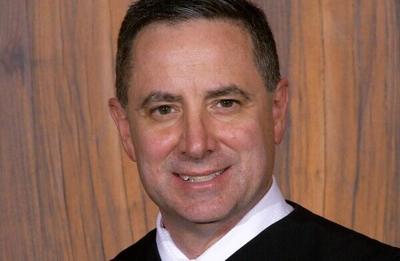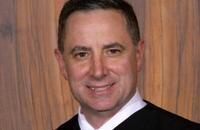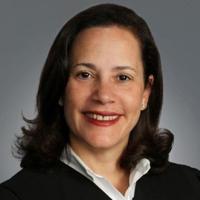
Illinois Supreme Court Justice David Overstreet
SPRINGFIELD - The Illinois Supreme Court has determined people asking courts to issue certificates of innocence must prove that innocence in fact and not just be victorious on legal grounds, including prosecutorial discretion and postconviction statutory amendments.
At the root of the decision is a December 2003 negotiated agreement in which James Reed pleaded guilty to one count of aggravated unlawful use of a weapon in exchange for prosecutors telling the court they didn’t intend to prosecute the other counts.
However, in 2013, the Illinois Supreme Court nullified the state law covering Reed’s guilty plea when it decided People v. Aguilar. Eight years later, Reed then secured a vacation of his conviction in 2021.
However, in 2022, a Cook County Circuit Court judge denied Reed’s request for a certificate of innocence, reasoning he couldn’t establish he was actually innocent of all four of the initial counts.
An Illinois First District Appellate Court panel agreed with the Cook County judge’s ruling, specifically finding Reed didn’t prove he was innocent of two charges of possessing a gun without a valid Firearm Owner Identification record, which remains illegal following Aguilar.
The Illinois Supreme Court affirmed both lower court rulings. Justice David Overstreet wrote the opinion, filed Oct. 23. Justices Mary Jane Theis, Lisa Holder White and Joy Cunningham concurred. Justice Elizabeth Rochford wrote a special concurrence, joined by Chief Justice P. Scott Neville and Justice Mary K. O’Brien.
In the decision, Overstreet explained the question was whether the state’s certificate of innocence law focuses only on offenses that lead to incarceration or every allegation in the initial filing, regardless of later prosecutorial discretion. He also noted four other exonerees filed a joint support brief supporting Reed’s appeal.
“The parties’ disagreement is derived from two distinct phrases used by the legislature in the COI statute: ‘offenses for which he or she was incarcerated,’ as provided in” three subsections, Overstreet wrote, and “offenses charged in the indictment or information,” elsewhere in the same law.
While the court agreed with Reed’s position that a certificate of innocence does pronounce someone “innocent of all offenses for which he or she was incarcerated,” Overstreet also said the law plainly and “clearly distinguishes between what a petitioner must prove — his innocence of the charges in the charging instrument — and the relief he requests and obtains if he satisfies that burden of proof — a COI declaring his innocence of the charges for which he was incarcerated.”
Certificates of innocence are often sought by people who assert they were wrongfully incarcerated. Such certificates have been used by such people to aid in lawsuits against police, prosecutors, cities and counties.
Like the appellate panel, the Supreme Court rejected Reed’s reliance on its 2021 decision, People v. Palmer, saying it didn’t establish unprosecuted charges are irrelevant. Overstreet further noted “the words ‘and prosecuted’ in Palmer were included in reference to the underlying factual context and were not germane to the court’s resolution of the issue in that case. The issue in Palmer involved a novel theory of guilt that was never charged, which implicated this court’s interpretation of the word ‘offenses.’ Because ‘offenses’ was repeatedly modified by the words ‘charged in the indictment or information,’ the Palmer court determined that ‘the legislature intended that a petitioner establish his or her innocence of the offense on the factual basis charged in the indictment or information.’ That conclusion in no way suggests that the word ‘offenses’ was limited only to the charges for which the petitioner was incarcerated, and we reject petitioner’s argument to the contrary.”
Overstreet said the state, in Palmer, deployed an uncharged accountability theory for the first time while litigating the certificate of innocence. In contrast, prosecutors have always focused on Reed allegedly possessing a gun without a FOID card.
“Implementing (Reed’s) proposed interpretation would violate several established rules of statutory interpretation,” Overstreet wrote, and effectively have the Supreme Court write conditions into the state law which the General Assembly didn’t pursue. He also noted Reed improperly conflated guidelines for pursuing damages after a wrongful conviction with the benchmarks for earning an innocence certificate.
Reed further argued an 1894 U.S. Supreme Court opinion, Dealy v. United States, established that when prosecutors tell a judge they won’t pursue certain charges, the result is the same as if those charges were never in the indictment. The state disagreed, saying the choice to abandon prosecution wasn’t a unilateral decision but a negotiated component of the plea deal. That distinction, the state argued, factored in the 2024 Illinois Supreme Court opinion People v. Smollett, when the Illinois Supreme Court agreed that special prosecutors couldn't pursue a conviction against actor Jussie Smollett for allegedly lying to police officers about the alleged hoax attack he suffered in Chicago in 2019.
In that case, the state high court reasoned the Cook County State's Attorney's office under former State's Attorney Kim Foxx had agreed not to prosecute Smollett, and that decision could not be upset by even a judge.
“Contract principles dictate that, if the petitioner’s conviction is later vacated, the parties are returned to the status quo before the guilty plea,” Overstreet wrote of the state’s position. “In this case, the status quo before the guilty plea included two charges of AUUW without a FOID card.”
Overstreet said the Dealy statement is inapplicable in that it has no connection to innocence certificate proceedings. Choosing not to pursue “certain offenses does not mean that the offenses were never charged, and it certainly does not constitute the state’s concession of innocence,” he wrote. “Nowhere does the COI statute provide that ‘offenses charged’ are limited to ‘offenses prosecuted.’ ”
Finally, the court rejected Reed’s argument that its opinion subverts the presumption of innocence afforded to criminal defendants by requiring him to prove something the state wasn’t trying to prove itself. The innocence certificate law, he wrote, “expressly states” someone requesting such a certificate must show, “by a preponderance of the evidence that he is innocent of the offenses charged in the indictment or information.”
In her special concurrence, Rochford said she agreed with the decision but raised concerns the majority’s analysis “could prove problematic under different factual scenarios.” While explaining there was no way to frame Reed’s conviction as “wrongful” — the state could’ve retained one of the two charges not later nullified under Aguilar — the circumstances of the exonerees who filed the support brief illustrated the shortcomings of a “one size fits all” approach.
“Nothing in the statutory language suggests that a petitioner does not have to prove his innocence of offenses for which he denied involvement or offenses for which the evidence consists of the testimony of a single witness,” Rochford wrote.
In Palmer, which involved exoneration of a murder conviction through DNA evidence, Rochford said, the courts didn’t require proof of innocence of a burglary charge stemming from a day prior to the murder although the state initially brought all charges together. Taking the majority’s blanket position, she continued, “would often require proof of things that are impossible to prove,” a position she said conflicts with lawmakers’ stated position in drafting the law “to avoid precisely these things.”
The proper path, she concluded, is requiring a nexus between a petitioner’s request for a certificate of innocence and any other charges in the original indictment. The particulars of such a nexus aren’t needed to decide Reed’s request, she said, adding “it would be preferable for the legislature, rather than this court, to clarify the precise reach of the phrase ‘the offenses charged in the indictment or information.’ ”
Jonathan Bilyk contributed to this report.







